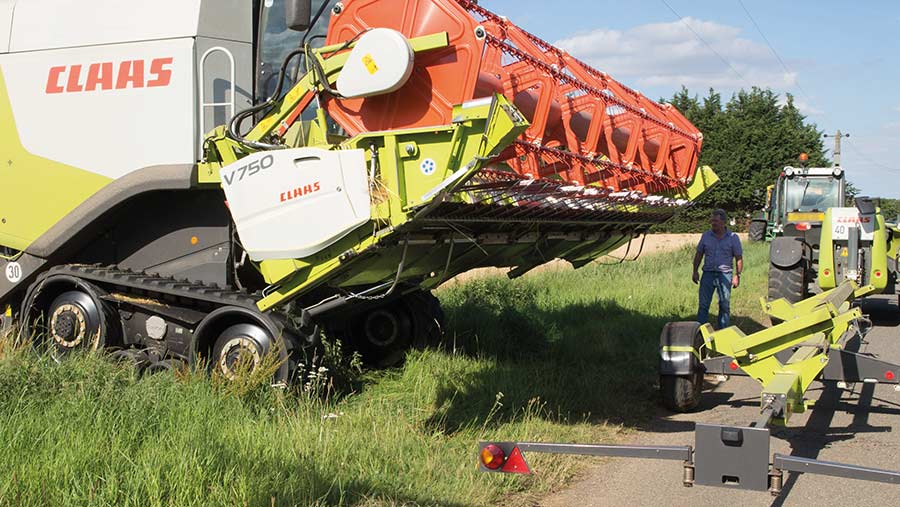Combine road safety: Is your header trailer up to scratch?
 © Tim Scrivener
© Tim Scrivener Farmers taking combines on the road at harvest time should check whether their header trailers are road legal and fit for purpose.
And with many large arable outfits now running tables of 7.5m or wider, it falls on owners to make sure they’re operating on the right side of the law when it comes to road transport.
Small header trailers are classed as an agricultural trailed appliance conveyor and don’t require brakes, provided they have an unladen weight of less than 510kg.
These can be towed behind the combine if it is less than 3m wide.
See also: Red diesel Q&A: HMRC rules untangled
Brakes and lights required
Any header trailer that weighs more than 510kg – pretty much all of those in regular use in the UK – is considered an agricultural trailer and, as such, must have brakes and lights, plus mudguards to stop any spray when it’s wet.
It can be towed behind a combine that is less than 3m wide, but the combination can’t be more than 18.75m long.
The regulations allow a maximum trailer length of 7m for single-axle trailers and 12m for twin-axle versions – a measurement of the body or bed length, excluding the drawbar.
As with the smaller trailers, the maximum length of the trailer and towing vehicle is 18.75m.
Exceeding these figures means notifying the local police force of any planned movements.
One important point to note is that a tractor towing the header trailer cannot be the escort vehicle for the combine if one is needed.
All blades, sharp objects and projections must be guarded when travelling on a public highway.
Speed restrictions
Most modern header trollies are classed as agricultural trailers and are usually fitted with inertia (overrun) type braking systems. Until recently, they had a load limit of 3,500kg and so, in many cases, were illegal in the UK.
However, in 2018 the law changed, allowing agricultural trailers to use such systems up to an 8,000kg limit when towed by a tractor.
This is provided the towing vehicle is “limited by design” to a speed of 30kph (19mph) if the brakes don’t act on all wheels, or 40kph (25mph) if they do.
Towing a header trolley with a 50kph (31mph) tractor at 30kph (19mph) or 40kph (25mph) is not technically permitted unless a speed limiter is fitted to stop it going quicker.
A 150mm-diameter display plate will need to be fitted to the rear of inertia-braked trailers to indicate the maximum speed it can be towed at.
This will be either 33kph (20mph) or 40kph (25mph) – the latter only permitted if the tractor and trailer combination is less than 2.55m wide; if it’s wider than 2.55m then the limit is 33kph (20mph).
Notify police
As with combines and tractors between 3m and 3.5m wide, you will need to notify the police at least 24 hours before you move it, or obtain an annual dispensation before harvest to allow for a bit more freedom. At this width, there is a speed limit of 33kph (20mph).
If the width exceeds 3.5m up to 4.3m, you will still need to conform with the above notification process, but a dedicated escort vehicle is required and the speed limit is 19kph (12mph).
For anything exceeding 4.3m wide, the Department for Transport must be notified.
There is an exemption from the above width requirements if you use roads with a speed limit of more than 40mph and you do not travel more than five miles.
The Abnormal Loads Department of your local police force will be able to help you obtain dispensations.

